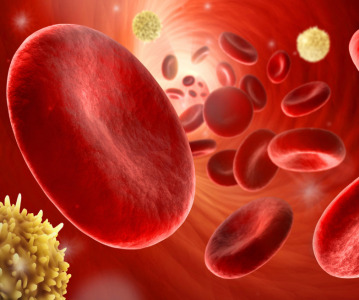Year-Round Preventive Treatment Reduces Malaria Risk in Young Children

A year-round preventive drug treatment substantially reduces young children’s risk of contracting malaria and poses no serious risk of adverse events, according to a study by researchers funded by the National Institutes of Health.
The findings demonstrate that prolonged treatment given from 6 to 24 months of age is safe and effective for young children, according to the study authors. Year-round preventive measures are badly needed in locations such as Uganda, where the study took place, and where malaria rates remain high throughout the year.
Most previous studies using drug treatment to prevent malaria have been limited to areas where there is only a seasonal risk of the disease, during the rainy season, when most malaria episodes in children occur. In those studies, preventive drug treatment was given for only a few months at most. The current study demonstrated that continuous preventive treatment can substantially reduce malaria transmission to infants, who are at greatest risk of severe malaria and death.
The study was conducted by Grant Dorsey, MD, of the University of California, San Francisco (UCSF) at San Francisco General Hospital, with colleagues from UCSF and the Infectious Diseases Research Collaboration, Kampala, Uganda, and Makerere University College of Health Sciences, also in Kampala. The researchers published their findings online in PLOS Medicine.
“This study has identified an effective measure for reducing the incidence of malaria in children living in an area with high rates of the disease,” said Lynne Mofenson, MD, chief of the Maternal and Pediatric Infectious Disease Branch at the NIH’s Eunice Kennedy Shriver National Institute of Child Health and Human Development (NICHD), which provided funding for the study.
Dr Mofenson said malaria poses a greater threat to children below 3 years of age than to older children. Malaria in children under age 3 is more likely to be fatal than in older children. In younger children, also, the disease may affect the brain and either prove fatal or result in brain damage.
“It’s better to try to prevent a potentially fatal illness than it is to wait until the child gets the illness and is at increased risk for dying,” Dr Mofenson added. Older children are considered to be less at risk from malaria because they tend to develop natural immunity against the disease as they get older.
The researchers found that a monthly dose of dihydroartemisinin-piperaquine (DP) was the most effective of three anti-malaria drugs at reducing malaria risk in children from 6 months to 24 months of age. The other two study drugs — monthly sulfadoxine-pyrethamine (SP) or daily trimethoprim-sulfamethoxozole (TS) — have been in use longer, and in many locations the malaria-causing parasite has developed a resistance to them. The researchers conducted the study to determine if the benefits of treatment outweighed the potential risk of anemia and other side effects from the drugs.
“When you’re giving drugs to prevent the disease, you have a much higher bar for safety,” Dr.Dorsey said. “When the drugs are given longer term, you may have an increased risk of side effects to contend with.”
Related News
-
News Google-backed start-up raises US$600 million to support AI drug discovery and design
London-based Isomorphic Labs, an AI-driven drug design and development start-up backed by Google’s AI research lab DeepMind, has raised US$600 million in its first external funding round by Thrive Capital. The funding will provide further power t... -
News AstraZeneca to invest US$2.5 billion in Beijing R&D centre
Amid investigations of former AstraZeneca China head Leon Wang in 2024, AstraZeneca have outlined plans to establish its sixth global strategic R&D centre in China. Their aim is to further advance life sciences in China with major research and manufact... -
News Experimental drug for managing aortic valve stenosis shows promise
The new small molecule drug ataciguat is garnering attention for its potential to manage aortic valve stenosis, which may prevent the need for surgery and significantly improve patient experience. -
News How GLP-1 agonists are reshaping drug delivery innovations
GLP-1 agonist drug products like Ozempic, Wegovy, and Mounjaro have taken the healthcare industry by storm in recent years. Originally conceived as treatment for Type 2 diabetes, the weight-loss effects of these products have taken on unprecedented int... -
News A Day in the Life of a Start-Up Founder and CEO
At CPHI we work to support Start-Up companies in the pharmaceutical industry and recognise the expertise and innovative angles they bring to the field. Through our Start-Up Programme we have gotten to know some of these leaders, and in this Day in the ... -
News Biopharmaceutical manufacturing boost part of new UK government budget
In their national budget announced by the UK Labour Party, biopharmaceutical production and manufacturing are set to receive a significant boost in capital grants through the Life Sciences Innovative Manufacturing Fund (LSIMF). -
News CPHI Podcast Series: The power of proteins in antibody drug development
In the latest episode of the CPHI Podcast Series, Lucy Chard is joined by Thomas Cornell from Abzena to discuss protein engineering for drug design and development. -
News Amgen sues Samsung biologics unit over biosimilar for bone disease
Samsung Bioepis, the biologics unit of Samsung, has been issued a lawsuit brought forth by Amgen over proposed biosimilars of Amgen’s bone drugs Prolia and Xgeva.
Position your company at the heart of the global Pharma industry with a CPHI Online membership
-
Your products and solutions visible to thousands of visitors within the largest Pharma marketplace
-
Generate high-quality, engaged leads for your business, all year round
-
Promote your business as the industry’s thought-leader by hosting your reports, brochures and videos within your profile
-
Your company’s profile boosted at all participating CPHI events
-
An easy-to-use platform with a detailed dashboard showing your leads and performance







.png)